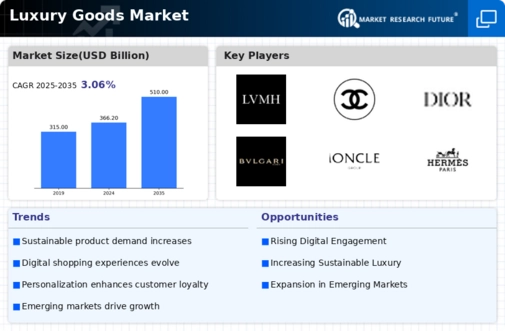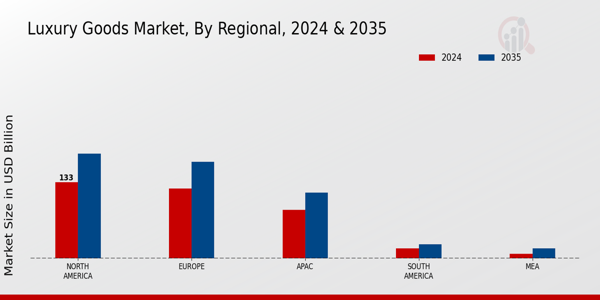Experiential Luxury
The Global Luxury Goods Market Industry is increasingly focused on experiential luxury, where consumers seek unique and memorable experiences rather than just products. This trend reflects a shift in consumer preferences, with individuals valuing experiences such as luxury travel, exclusive events, and personalized services. As the market is projected to grow at a CAGR of 3.06% from 2025 to 2035, brands are adapting their offerings to include experiential elements. For instance, luxury hotels and resorts are enhancing their services to provide bespoke experiences, thereby attracting affluent consumers who prioritize experiences over material possessions. This shift may redefine the luxury landscape in the coming years.
E-commerce Expansion
The Global Luxury Goods Market Industry is witnessing a substantial shift towards e-commerce platforms. With the proliferation of digital technology, luxury brands are increasingly investing in online sales channels to reach a broader audience. In 2024, the market is expected to achieve a valuation of 366.2 USD Billion, with e-commerce playing a pivotal role in this growth. Brands are enhancing their online presence through immersive shopping experiences and personalized services. This trend is particularly pronounced among younger consumers who prefer the convenience of online shopping. As e-commerce continues to evolve, it is likely to reshape the purchasing landscape for luxury goods.
Sustainability Trends
Sustainability is becoming a crucial driver in the Global Luxury Goods Market Industry. Consumers are increasingly seeking brands that demonstrate environmental responsibility and ethical practices. This shift is prompting luxury brands to adopt sustainable materials and transparent supply chains. As the market evolves, it is projected to reach 510 USD Billion by 2035, indicating a growing demand for eco-friendly luxury products. Brands that successfully integrate sustainability into their business models may attract a loyal customer base, particularly among millennials and Gen Z consumers. This trend suggests that sustainability will not only influence purchasing decisions but also shape brand identities in the luxury sector.
Market Growth Projections
The Global Luxury Goods Market Industry is projected to experience substantial growth over the next decade. With an anticipated market size of 510 USD Billion by 2035, the industry is poised for significant expansion. The projected CAGR of 3.06% from 2025 to 2035 indicates a steady increase in demand for luxury products. This growth is likely to be fueled by various factors, including rising disposable incomes, the expansion of e-commerce, and changing consumer preferences towards experiential luxury. As brands adapt to these trends, the luxury goods market is expected to evolve, presenting new opportunities and challenges for industry players.
Rising Disposable Incomes
The Global Luxury Goods Market Industry is experiencing growth driven by rising disposable incomes across various regions. As consumers in emerging markets, particularly in Asia-Pacific, gain financial stability, their purchasing power increases. This trend is evident as the luxury goods market is projected to reach 366.2 USD Billion in 2024, reflecting a growing appetite for premium products. The increasing middle class in countries like China and India is likely to contribute significantly to this growth. As these consumers prioritize luxury items, brands are adapting their strategies to cater to this demographic, enhancing their presence in these lucrative markets.
Technological Innovations
Technological innovations are playing a pivotal role in shaping the Global Luxury Goods Market Industry. Advancements in areas such as augmented reality, artificial intelligence, and blockchain are enhancing the consumer experience and operational efficiency for luxury brands. In 2024, the market is anticipated to reach 366.2 USD Billion, with technology facilitating personalized shopping experiences and improved customer engagement. Brands are leveraging these technologies to create unique marketing strategies and streamline their supply chains. As technology continues to evolve, it is likely to drive further growth in the luxury sector, enabling brands to connect with consumers in innovative ways.























